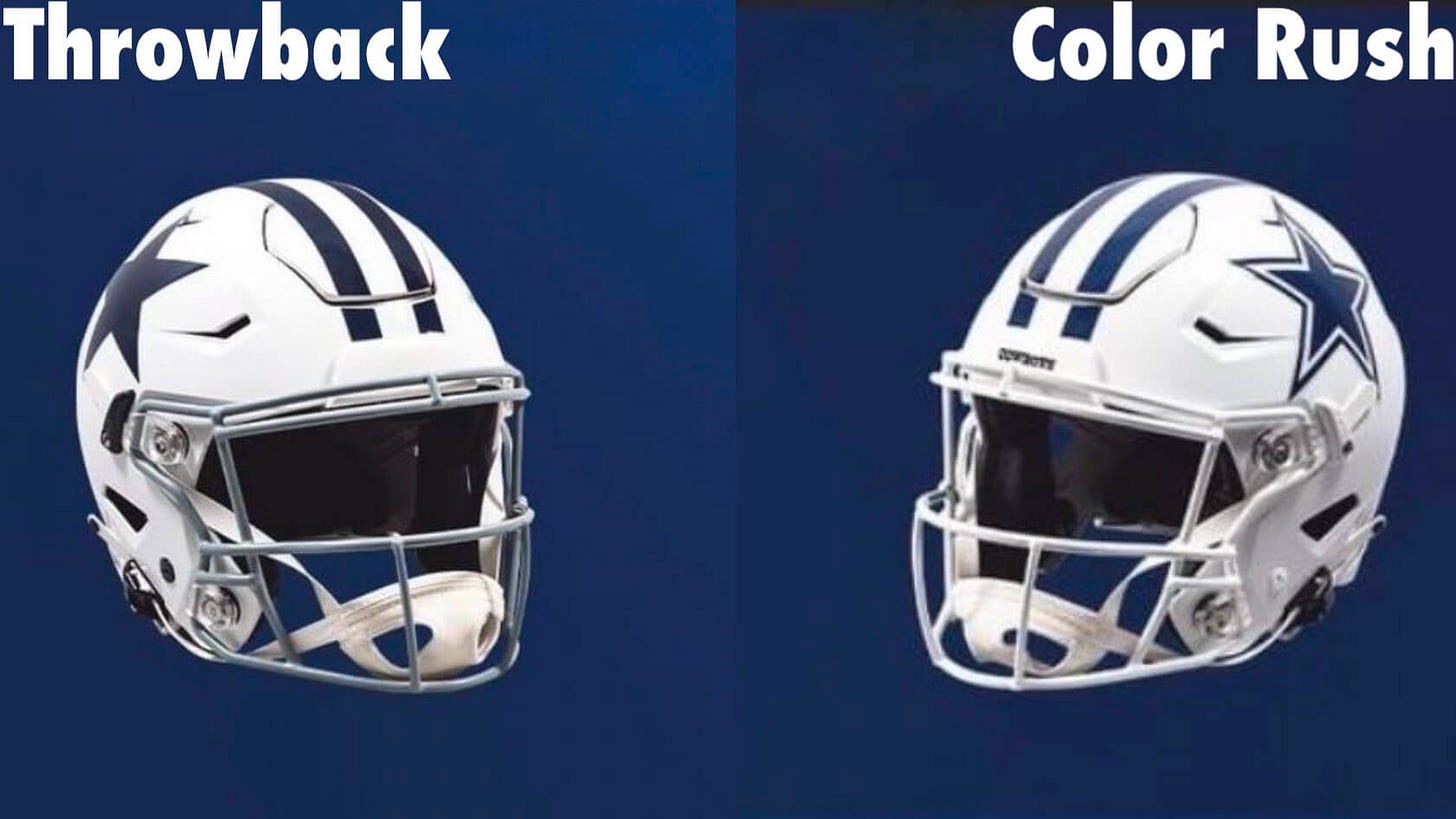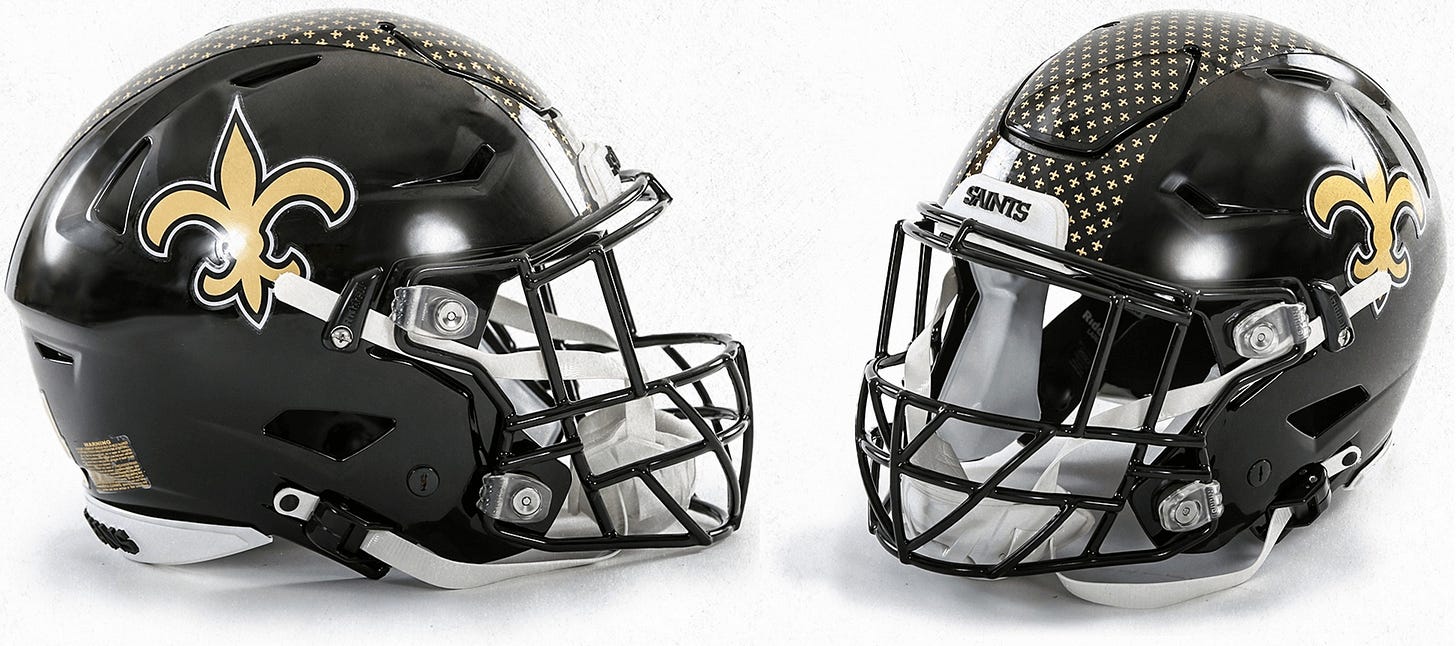The ‘Uniform Geek’ Overseeing the NFL’s On-Field Look
From full-scale makeovers to tiny tweaks, everything runs through Jonathan Wright, the NFL’s Senior Director for Uniforms and On-Field Products.
Last week I introduced you to Doug Murphy, the New York Giants’ director of creative services, who’s been a longtime unsung hero in the NFL uni-verse. Today we’re going to meet another key figure who works behind the scenes on NFL uniforms — but this time it’s someone who works at the league office, not for a particular team.
The impetus for today’s article came about a month ago, when the Patriots’ website published an article explaining how the team had helped push for the lifting of the one-shell rule. One of the people quoted in that article was Jonathan Wright, the NFL’s Senior Director for Uniforms and On-Field Products, and what really caught my eye was this quote he gave about himself: “I’m a uniform geek, what am I going to say. It’s a weird little niche that I’ve fallen into, but I love it.”
Truth to tell, I’d seen Wright’s name come up now and then over the years (he’s been with the NFL since 2014), but I never sought him out because I figured anyone at his level would be, well, too corporate. After seeing that quote, though, I figured we should get acquainted, so I emailed him and asked for an interview. When we sat down for a Zoom call last week, he said that when he saw my interview request in his in-box, he thought to himself, “He finally found me.”
Here’s a transcript of that Zoom call, edited for length and clarity.
Uni Watch: I saw that article on the Patriots’ website where you described yourself as a uniform geek. Is that something that goes back to when you were a kid? Like, were you drawing uniforms and logos during your childhood?
Jonathan Wright: No. And it’s funny, because when I sit in these [NFL] meetings, I always say that I am probably the least creative person in the room. That’s somewhat tongue-in-cheek, but I’ve never been an artist or into drawing or any of these things. I think I was more drawn to the aesthetic and the manufacturing of uniforms.
I think I first realized it when I was in high school. I had a job at Olympia Sports, and I bought a pair of Fab Five [Michigan basketball] Nike shorts, with the full twill Ms on the sides. I spent 75 bucks on them. And you can imagine what my parents said when I came home and told them that, in 1991, I spent $75 on a pair of shorts. But I will say this: I still have those shorts.
UW: So that sort of clicked or toggled some sort of switch in your brain?
JW: Yeah, it did. And I didn’t really realize until I got to college and walked into one of my fraternity brothers’ rooms, and he had hockey jerseys up on the wall. And you know, I was just drawn to them — I started touching them and feeling them and looking at them. He collected game-worn jerseys from enforcers, so they were really thrashed. This wasn’t the era of, “Hey, we’re going to wear a new jersey every game” — it was “Hey, here’s your jersey for the entire season, get out there and play.” So they showed the signs of wear and blood and rips and tears and all that stuff.
He and I ended up starting our own business, selling game-worn jerseys. So, you know, it’s funny: I’ve never done anything in my professional career that hasn’t involved uniforms. It’s so strange.
UW: How did you go from that to the NFL? Because I know you worked for some apparel companies in between, right?
JW: Yes. Our game-used jersey business was super-niche — basically a niche within a niche within a niche, because we were specializing in enforcers. When the [2004-05] NHL lockout happened, that really cut down on our volume, so we tried other revenue streams, but this was before social media and all that, so we realized that we needed to get “real jobs.”
So one day my wife goes, “Take a look at this.” It was a job posting at Reebok for a jersey specialist. I was like, “Does it really say that? Like, that’s a thing?” Basically, they wanted somebody to come in and help build their retail business for the NHL, although the job posting didn’t say that. So when I went in for my interview, I brought game-used hockey jerseys with me, not even realizing that they were looking for a hockey guy. So naturally they think, “This is our guy,” right?
So I started doing that and soon I was doing more on the development side — working closely with the league, making sure the new Reebok silhouette got off the ground, commercializing it, making all this stuff for retail while working very closely with the on-ice group. Then I was managing development for on-field for the NFL, the NHL, college basketball and NBA, and retail NHL.
So I was doing that for a while. And to be honest, we built such a good team and such a well-oiled machine that after a couple of years I kind of got bored. So I moved over to the product side for Adidas and I worked in their team sports division, outfitting colleges and high schools for three or four years — uniforms, sideline gear, training gear, everything.
So one day I’m having lunch with a colleague and she asks if I’ve heard that Ember Morr at the NFL was leaving. She was the person who had my current position before I came to the NFL, so I worked with her when I was with Reebok, because Reebok was the NFL’s uniform licensee at the time. And I said, “No, I hadn’t heard that.” So I applied, and I went through the interview process, and it kind of just all happened really quickly.
When I interviewed, Dennis Kayser, who became my boss, said, “Thank God you applied for this, Jon. The only applications we’ve gotten so far are from really technical people who want to develop fabrics and stuff like that. And you know, we have partners that do that. We’re looking for somebody who can manage the partnerships, work with our equipment managers, work with front offices, with owners, and build those relationships.” And now I’m here.
UW: Your title is Senior Director of Uniforms and On-Field Products. What does that entail? Does it include the retail side?
JW: It includes all of it. I probably have eight or nine pillars of things that fall under my purview. Everything from working with a club when they do a uniform change, all the way down to the people who hand out the caps and T-shirts after a conference championship or Super Bowl. I work with our equipment managers, I work with our partners at Nike and Adidas and anybody that has on-field product.
UW: Describe a typical Sunday during football season for you. Where are you, which games are you watching, and what are you looking for and noticing that the average fan might not notice?
JW: I am either at a game or I am at home on RedZone — not only because it’s awesome, which it is, but it allows me to peek in at all the games without me having to flip the channel.
If I know a team’s gonna be wearing something new, I’ll certainly tune in for a little while to see how it looks on-field. But I also try to make sure we support our football operations department and make sure there is compliance on the field. And when I say that, it’s not so much about a guy wearing his socks down — it’s more along the lines of protecting our partners that pay for the right to be on our field, as opposed to [non-licensed] things being out there that amount to free advertising.
UW: Let’s say a team makes a relatively small change to their uniform…
JW: The 49ers.
UW: Yes, that’s exactly the example I was going to cite. This year, they’ve changed their sleeve striping and their chest wordmark. How involved are you in the process of making those tweaks and so on? Does even a small thing like that run through you and your office?
JW: Yep. Even the slightest change goes through me. But really, whether it’s a small change or a big one, there’s really no difference in the process, no difference in how that affects retail.
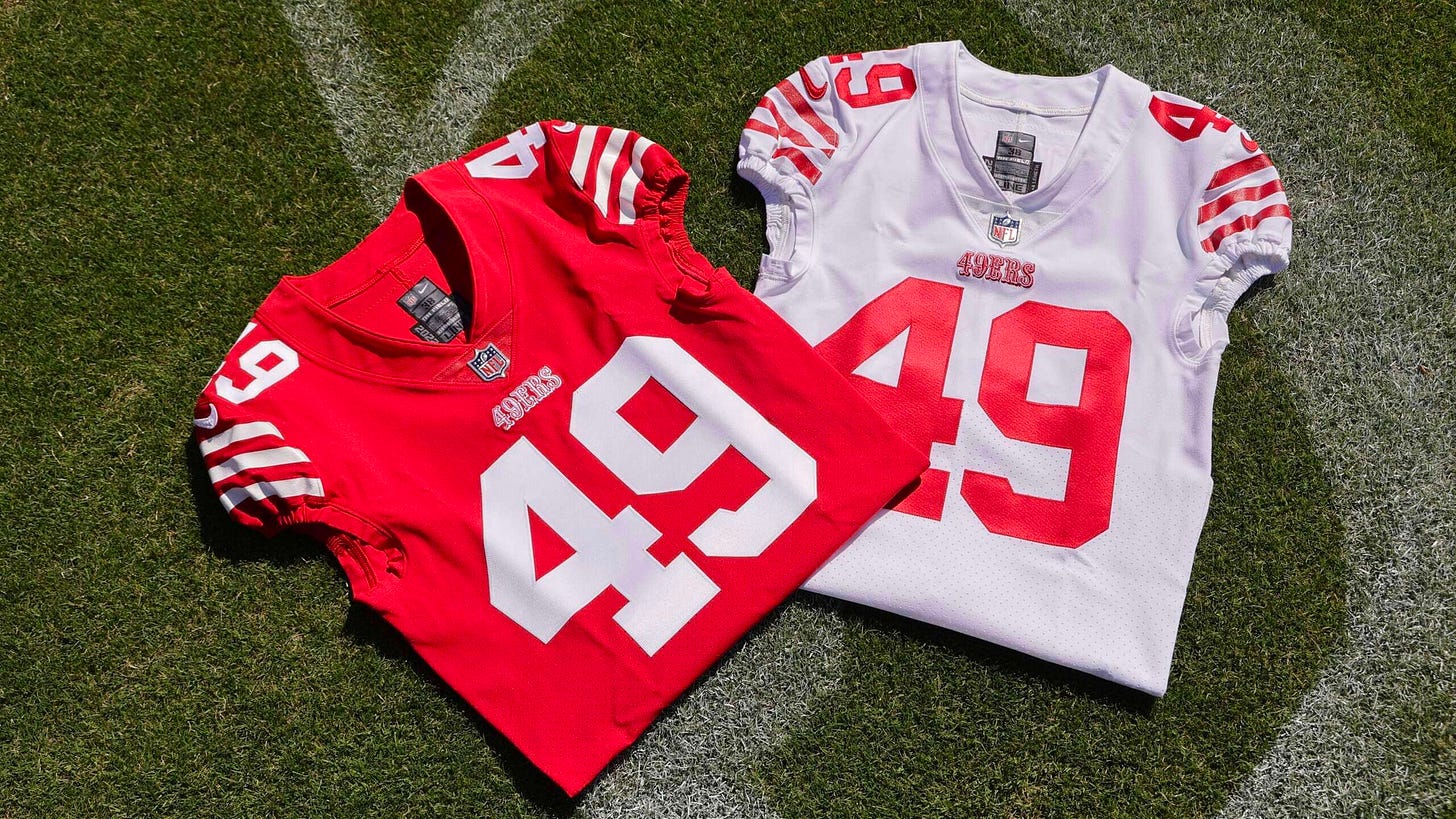
UW: So whether it’s something seemingly minor like what the Niners have done this season, or a complete overhaul like what the Rams did a few years ago, you’re saying it’s all the same from your perspective?
JW: Exactly. It might be a little less on the conversational side, but the operational part is no different.
UW: So when we hear a team saying that it takes two years or whatever to get a uniform change done, that would be the same for the Rams or the Niners.
JW: Correct.
UW: What about something that’s basically at the equipment level, like the Bills changing from grey facemasks to white last season? Obviously, that doesn’t have the same retail implications, because you don’t sell helmets the same way you sell jerseys. Are you involved in that, and does that have to be in the pipeline just as long?
JW: In theory, something like that has to be in the pipeline just as long. But there are certain cases — like, for that one, we didn’t constitute that as a uniform change.
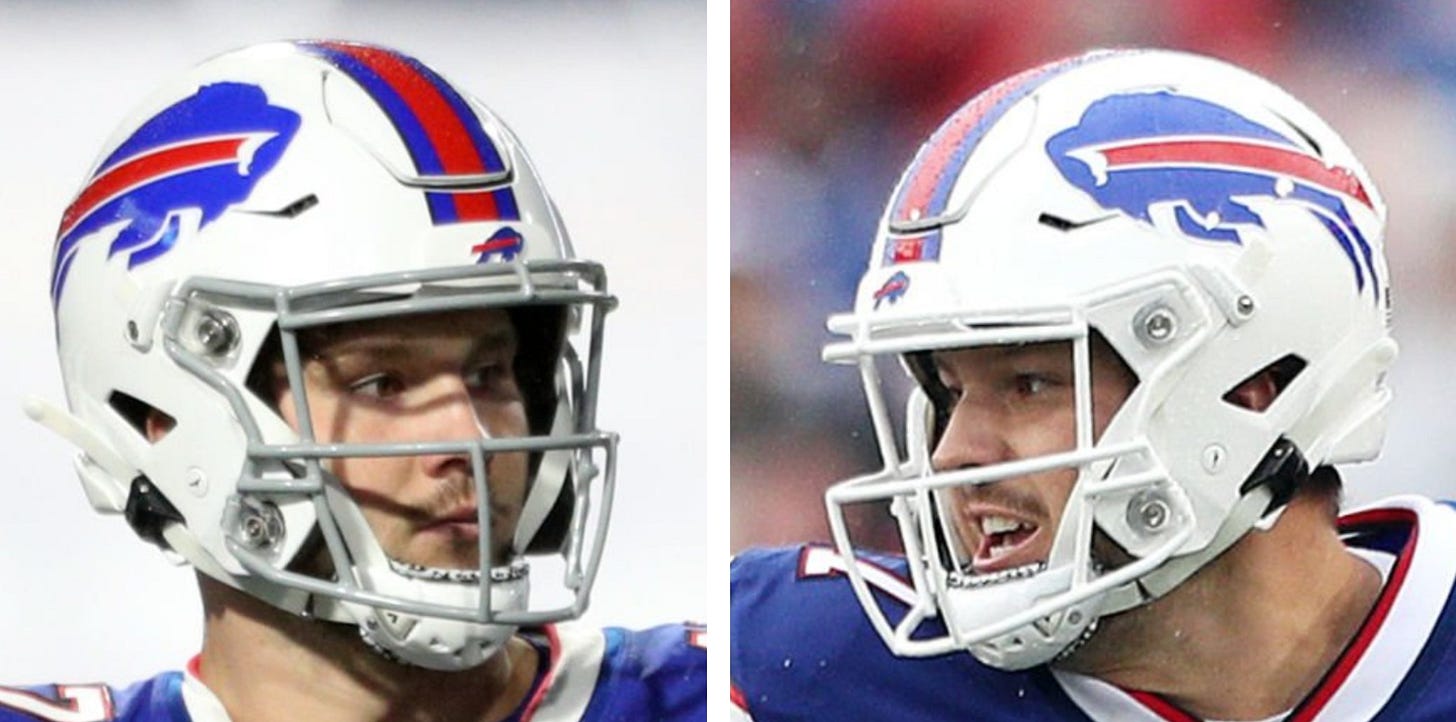
UW: Oh, so that doesn’t reset their five-year clock for uniform changes?
JW: Right.
UW: What about something like an anniversary patch or a memorial decal on the back of the helmet? I assume that runs through you as well, but I also assume the timelines are different. You know, if somebody passes away in the middle of the season, a team may have a patch or a decal that very next Sunday.
JW: Yes, that all comes through me as well. We help out as much as we can to help get quick turnarounds.
UW: Do you ever see a team planning something that seems sort of risky or questionable? I’m thinking here of something like the Jaguars’ two-tone helmet, or the Rams’ bone uniforms — do you ever see something like that in the pipeline and think to yourself, “Hmm, I’m not sure fans are gonna like that,” or “Maybe that’s not such a good idea”? Like, you can almost see the train wreck coming before it happens? And if so, do you try to dissuade the team, or do you just stick to executing their vision, what it happens to be?

JW: Like I said before, I’m the least creative person in the room, but we do have input. We have a team that leads our new creative department here, so that team is charged with giving their recommendations. There’s a lot of discussion — each situation is so unique and so different. Everything is subjective, and it’s not my place to say yes or no. If I’m asked, I’ll give my honest opinion. But at the end of the day, it is the club’s choice on how they want their brand to present on the field.
UW: Now that teams can add a second helmet color, this must be a particularly busy period for you.
JW: Paul, I gotta be honest: I had no idea it would cause such a huge workload influx. I mean, I knew I was signing myself up for more work…
UW: At least you’re not bored, like when you were at Reebok, right?
JW: Definitely not. And you know, we spent a lot of time putting this whole program together, and then we sent it out to the clubs and they came back with these amazing questions that we hadn’t even contemplated.
UW: Can you give me an example?
JW: Sure. The Cowboys said, “So now we have this white throwback shell. But if we wear it with our white Color Rush jersey, can we also change out the decals and the facemask?” We hadn’t thought of that, but sure. So they get to wear that new helmet in different ways.
UW: One thing that surprised me with these new helmets is that just about all of them are using the team’s standard helmet logos that we’re already used to seeing on their primary helmet colors. For the Bears’ new orange helmet, for example, they could have used their bear’s head alternate logo, but instead they went with the standard wishbone-C. Any thoughts on that?
JW: You know, it’s an interesting question. I thought the same as we were going through it. Some teams kind of pushed that a little bit, like the Saints, by putting all those little fleur de lis down the center…
UW: Yeah, but it’s still basically their standard logo on the sides.
JW: That's true. But you know, with any new program there’s this sense of “How far do we want to take this? How is this going to be received?” We’re just getting started with this program, so I wouldn’t be surprised if we see these things starting to evolve over time.
UW: That leads me to this question: NFL teams have one or now two helmets. usually no more than three or four uniforms. But in the NCAA, we’ve seen teams — and not just Oregon — going with four, five, six different helmets, loads of different jersey and pant combinations, and so on. Is the move move toward multiple helmets the start of a sequence that will ultimately result in the NFL moving to a more NCAA-like system, where teams have lots of different helmets, lots of different jerseys? Or will the NFL uniform scene always be less freewheeling than the NCAA scene?
JW: The NFL will definitely always be less freewheeling, and I say that with full confidence because the college teams use it as a recruiting tool. I was part of that when I was at Adidas — we had a bunch of schools that really wanted to push the envelope, because they were using it for recruiting. It was like being part of the uniform wars. Like, could we make a cooler uniform than Nike? Could we make a cooler uniform than Under Armour?
But with the NFL, it’s all rooted in [team] brand equity. So we have the “required” side of the closet, which is your primary white and team-colored uniforms. And then we have the “optional” side. And that’s why it’s built that way, to make sure that there is brand equity, so people know who’s playing when they turn on the TV. People have that connection to the primary logos, primary uniforms, and then you can have these other things sprinkled in as the team sees fit, but the core look still needs to be the norm.
UW: I feel like there’s a lot of confusion about some of the NFL uniform rules. We hear that a team can only change its uniforms once every five years, but then you mentioned earlier that certain changes, like the Bills’ facemask color, don’t really count as a change. With these new alternate helmets, we hear that they’re only allowed to wear the alternate helmet with alternate uniforms. But then it turns out that the Panthers are going to wear their new black helmet with their black jersey, which is their primary jersey color. So I’ve had fans asking me, “Did the Panthers redesignate black as their alternate jersey? And is blue their new primary jersey now?”
JW: This is where it’s helpful to think about the closet and how teams approach it. So they actually only have three uniforms, right? So they have a fourth slot that’s open. So basically, what they did was they reclassified their [mono-]black [combo] as their second Color Rush [in addition to the mono-blue combo, which is their first Color Rush]. So we were able to stick that into the fourth slot in the closet.
UW: So even though black is their primary jersey color by itself, the combination of wearing it with black pants is considered an alternate uniform.
JW: Exactly.
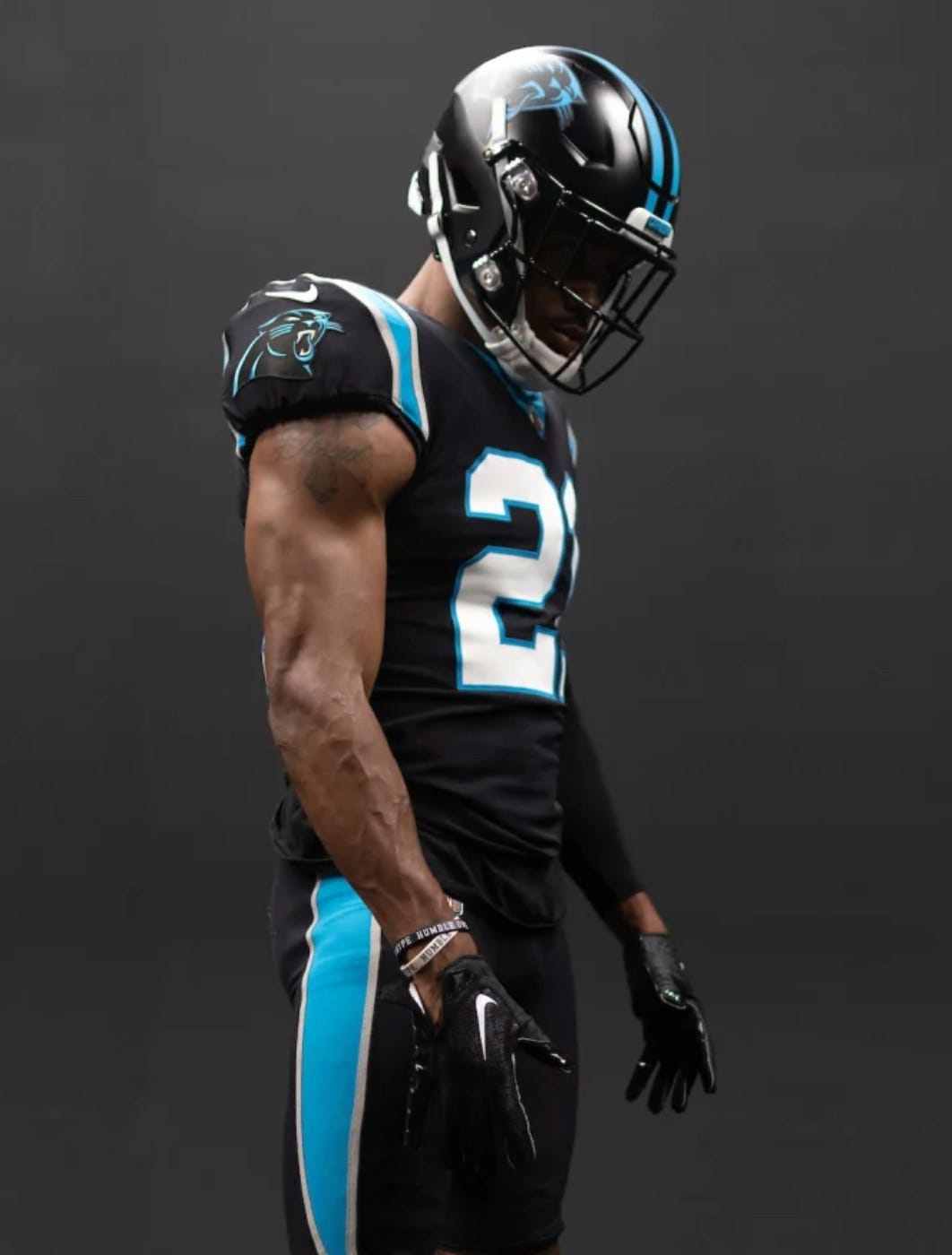
UW: Similarly, the Bengals are apparently planning to wear their new white alternate helmet with their white Color Rush jersey and their primary white pants — not the original pre-2021 Color Rush pants. If they can pair the new helmet with the primary pants, why not just let them wear the primary white jersey too? I mean, I understand the whole idea of pairing alternate helmets with alternate uniforms, the whole “two sides of the closet” concept, but in this case it seems odd to revive the Color Rush jersey, which wasn’t worn at all last season, especially when the new primary white jersey is so similar.
JW: The the “two sides of the closet” idea is the defining line for how the program was set up. In speaking with the club, we felt that this was a reasonable and on-brand way to tie this together. But as with all of our uniform policies, we are always evaluating, to give teams maximum flexibility.
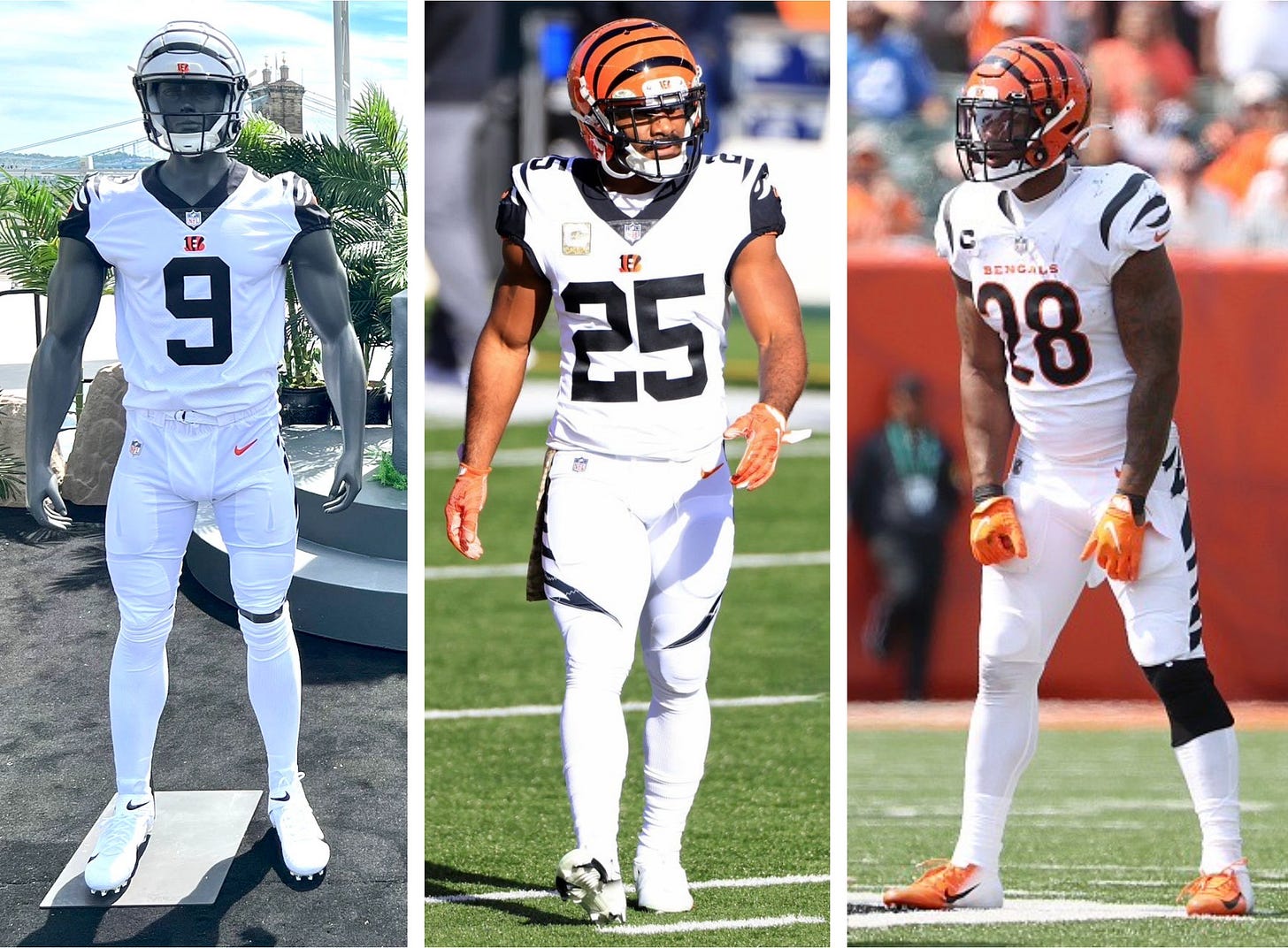
UW: As Riddell and Schutt and other manufacturers keep coming up with these new helmet designs that have vents and ridges in unusual places, it’s getting harder for some clubs to position the team logo in its usual spot. Do you think the day is coming when the sport may have to rethink the standard helmet format of having the logo on the sides, because it may not work on these newly engineered helmets?
JW: That’s a good question. To be honest, Paul, if a team wanted to take a different approach to their helmet design, we wouldn’t stand in the way. And look at the Commanders’ alternate helmet: They’ve got the “W” in the front, the flag in the back, and numbers on the sides.
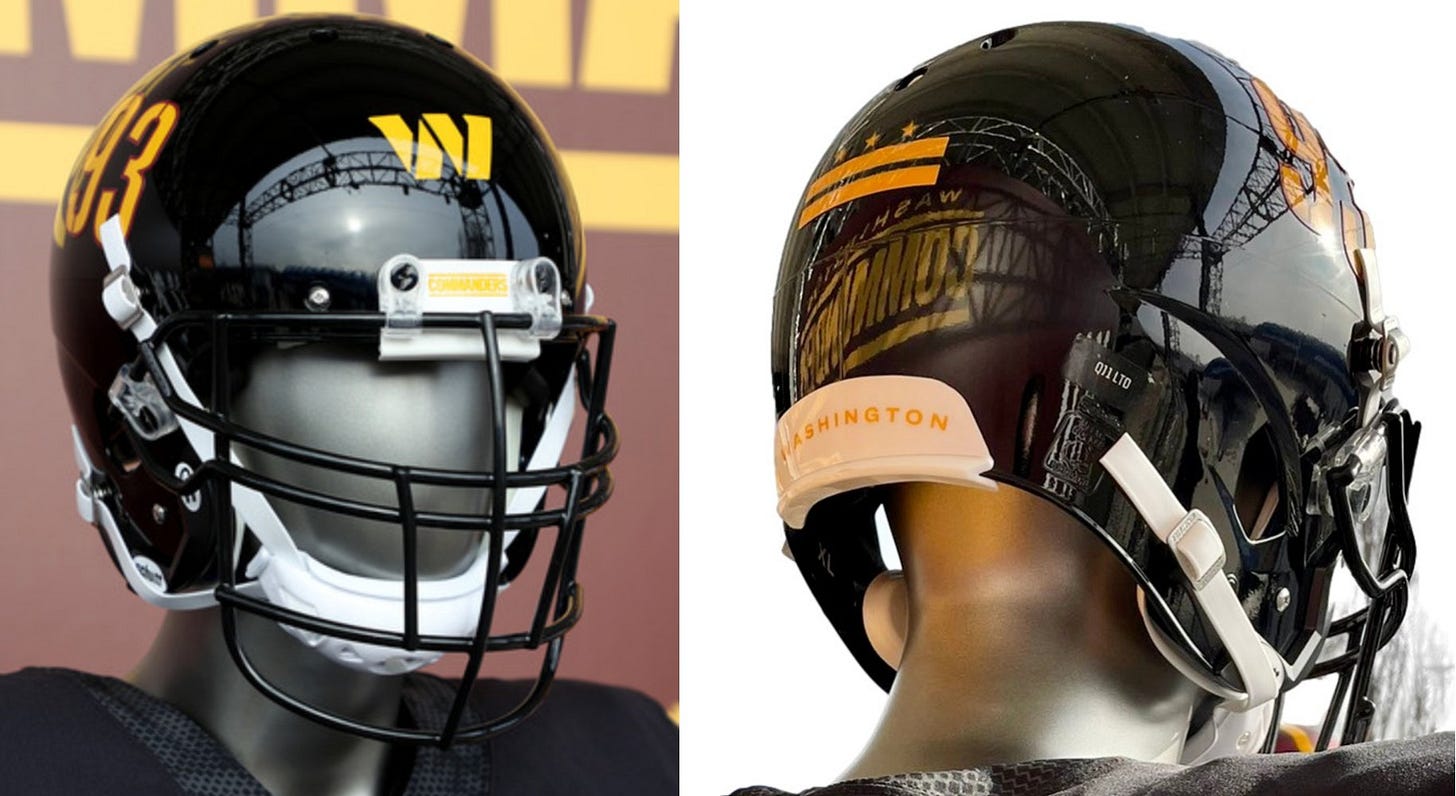
UW: NBA uniforms have had advertising patches since 2017. The NHL will start doing that this fall, and Major League Baseball will follow next spring. That will leave the NFL as the only major North American pro league without advertising on its uniforms. Is that something you’re proud of? Something you think needs to be addressed? Something you folks have discussed?
JW: I’ve learned to never say never, but I don’t foresee it happening, at least not in the near future. I think we are proud of the fact that we have these clean uniforms. I personally am. Aesthetically, I don’t think it’s pleasing to the eye [to have ad patches], nor does it fit with a team’s brand. It just feels kind of wonky.
UW: You guys have a schedule of Thursday-night games. Fans tend to love throwback uniforms. Have you considered “Throwback Thursdays”?
JW: We haven’t yet. You know, this always comes down to not knowing the schedule in advance, not knowing who’s playing. So what do we do if we have a game where both teams’ throwbacks are navy? We kind of went through this with Color Rush. I’ve extrapolated this out, as I’ve had similar types of thoughts, and ultimately it always comes down to the available uniforms and the schedule. And we always know the schedule after the uniforms are all done, so making a pivot at that point becomes almost impossible.
UW: Technically, every NFL uniform includes an official sock design. In reality, as you know, some players wear socks, others wear tights or leggings, still others wear something like leg-warmers or calf sleeves, some players just wear white instead of a team color. In short, this seems to be the least uniform part of the uniform. Is it time for the NFL to reconsider whether players should even be required to wear socks at all, because it’s become such a free-for-all?
JW I don’t think we would ever have a scenario where you could just be showing bare skin, like they do in college. I would say the most likely outcome would be to create language or change the language so that the guidelines match what’s actually happening on-field. Just last year we just changed the language so that it says “socks” instead of “stockings.” Last year! Sometimes we have to review these things to keep them up to date.
UW: All right, let’s do some lightning round questions, starting with this: What’s your favorite NFL uniform?
JW: Right now, I’d say the Pats’ throwback.
UW: I don’t want to ask what’s your least favorite, because I understand how that could put you in a tough spot, but how about one that you’re maybe not as fond of?
JW [after lengthy pause]: Pass.
UW: Very diplomatic! What’s one uniform from the past that you’d most like to see revived as a throwback?
JW: That’s a really good question. Honestly, I would really love to see the Oilers.
UW: True or false, as a prediction: The Browns will never ever wear a logo on the side of their helmet.
JW: True.
UW: I think that’s it from my end. Anything you want to add?
JW: Just that I appreciate how important uniforms are to fans, and to the ecosystem of the sport. I mean, if you say a team name, you think of their uniform — either that or the logo. Even when a new design leaks, which is soul-crushing, but it just shows you how much people care about this stuff. You go to a game or a tailgate, and how many people do you see wearing a jersey? You go to somebody’s house on a random Sunday, same thing — even if it’s not football season! I understand how important all of this is, so I really try to put my heart and soul into the job.
———
Paul here. Really interesting stuff! Shame on me for not having sought out an interview with Wright before now, and big thanks to him for sharing his time and expertise with the Uni Watch comm-uni-ty. I hope to check in with him again as the NFL season moves forward.
(Header photo: Mark Hoffman, USA Today Sports)
Paul Lukas has been writing about uniforms for over 20 years. If you like his Bulletin articles, you’ll probably like his daily Uni Watch Blog, plus you can follow him on Twitter and Facebook and check out his Uni Watch merchandise. Have a question for Paul? Contact him here.





